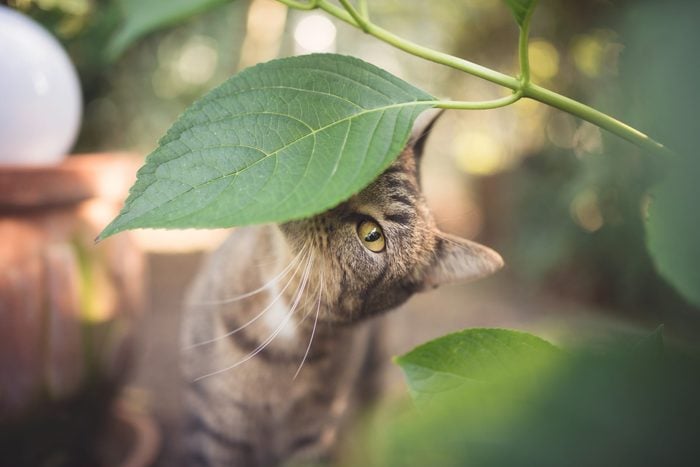
Plants and your cat
Plants can bring a room to life, and that’s likely what you’re thinking about when you buy them. But if you’re a pet parent, it’s important to double-check whether an indoor plant is toxic before bringing it into your home—or if these toxic plants are already in your home. In minor cases, plants toxic to cats can cause gastro upset or skin irritation, but in serious cases, they can lead to organ failure, seizures or even death.
Cats nibble on plants to get extra nutrients and fiber, just like humans do, but unfortunately, they don’t always know the difference between good plants and bad plants. For that reason, it’s your responsibility to ensure that your feline doesn’t have access to any houseplants poisonous to cats. With expert help, we’ve outlined some of the most common houseplants and outdoor/garden plants every cat owner should keep out of reach of their cats. We’ve also provided suggestions for the perfect nontoxic replacements, as well as where to buy these plants online. While you’re at it, make sure to review the plants that are poisonous to dogs too.
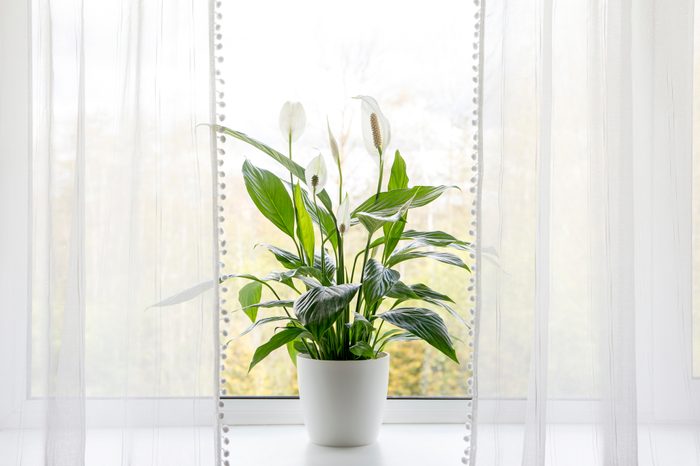
Lily
Lilium
Toxic components: Insoluble calcium oxalates
This indoor plant may be beautiful, but it’s highly toxic—even life-threatening—to cats, says Shelly Zacharias, DVM, a veterinarian and vice president of medical affairs at Gallant. “Lab work, including blood and urine, will be checked at various time points over a span of several days [if your cat consumes lilies],” says Dr. Zacharias. “Depending on these results, the veterinarian will discuss a monitoring plan for kidney function or long-term therapy, if needed.”
Swap it: In lieu of lilies, opt for a white orchid. They’re nontoxic to pets, gorgeous and surprisingly easy to take care of. Love plants? Here are a few of our favorite plant subscription boxes.
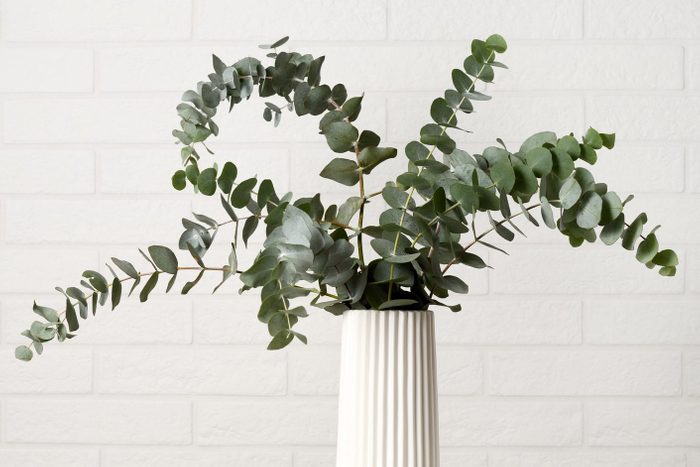
Eucalyptus
Myrtaceae
Toxic component: Eucalyptol
Popular for its fragrant, mind-soothing leaves, the pale green eucalyptus plant should be kept out of reach of cats. “When a cat consumes enough eucalyptus leaves to get sick, we expect to see signs like drooling, vomiting, decreased appetite and diarrhea,” says Jo Myers, DVM, a veterinarian expert for JustAnswer. “Those symptoms are expected to be relatively minor and to go away without any specific treatment within 24 hours.” She adds that even higher concentrations of eucalyptol are found in eucalyptus essential oils, so be mindful when using these products.
Swap it: Rosemary, which is also known for its wonderful scent, is an excellent replacement for eucalyptus. Fun fact: Rosemary is also a plant that repels mosquitoes.
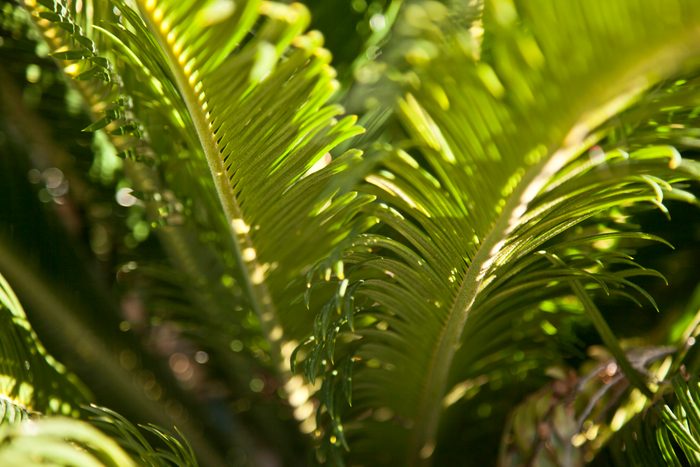
Sago palm
Cycadaceae
Toxic component: Cycasin
Palms add wonderful lushness and tropical vibes to a room, but not all are pet-friendly. The sago palm contains cycasin, which is extremely toxic to cats, notes the ASPCA. It should be completely avoided, as it can cause dangerous gastrointestinal and liver damage, and in some cases even death. The smaller the pet, the more greatly it will be impacted.
Swap it: For a similar tropical vibe, try the parlor palm instead. It’s a breezy, bright green plant that’s also known as the bamboo palm or good luck palm. To be really safe, you may want to go with one of these artificial plants you can’t tell are fake. (Really!)
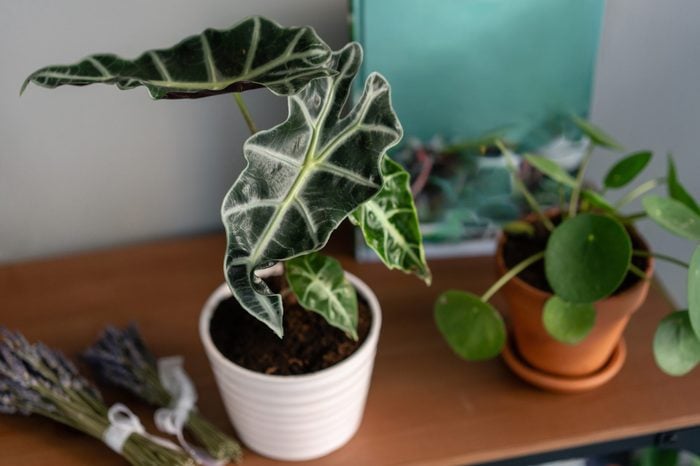
Elephant’s ear
Alocasia
Toxic components: Insoluble calcium oxalates
It’s leafy and exotic-looking, so it’s no wonder the alocasia is such a popular houseplant. Unfortunately, it’s a no-go if you have a cat because it contains insoluble calcium oxalates that cause kidney failure, notes the ASPCA.
Swap it: The calathea medallion offers the same tropical vibes and rich green foliage that the alocasia does, but it’s completely safe for your kitty. It is also a low-maintenance plant that even those without a green thumb can keep healthy. By the way, this is what’s going on with brown tips on your plant’s leaves.
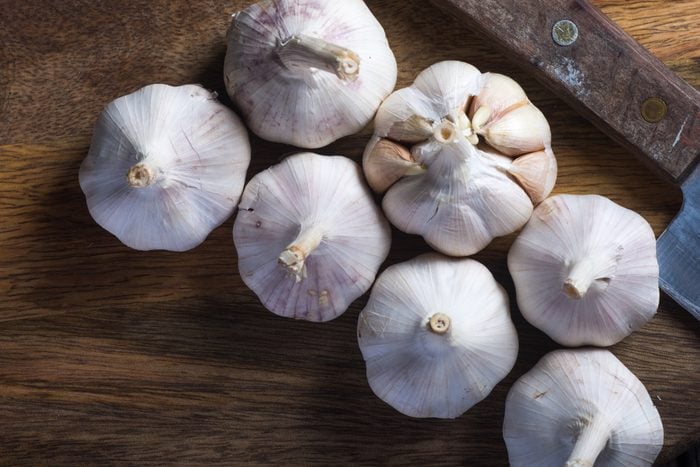
Garlic
Liliaceae
Toxic components: Disulfides
Almost every home has garlic in it at one point or another. We’re not saying you have to completely forego this savory addition to food, but it’s important to keep it away from your cats. Dr. Myers explains of this houseplant that’s poisonous to cats, “The chemicals that give [garlic] its pungent odor can also damage a cat’s red blood cells.”
In addition to keeping garlic in a sealed container, be mindful of sharing food with your cat if it’s been prepared with garlic. And as a general rule, if cats are fed table food, it should always be plain and preapproved by your vet.
Swap it: Rather than swapping, focus on being vigilant about your garlic storage and usage. Dealing with gnats swarming your produce and plants? Here’s how to get rid of fruit flies—and why they show up in the first place.
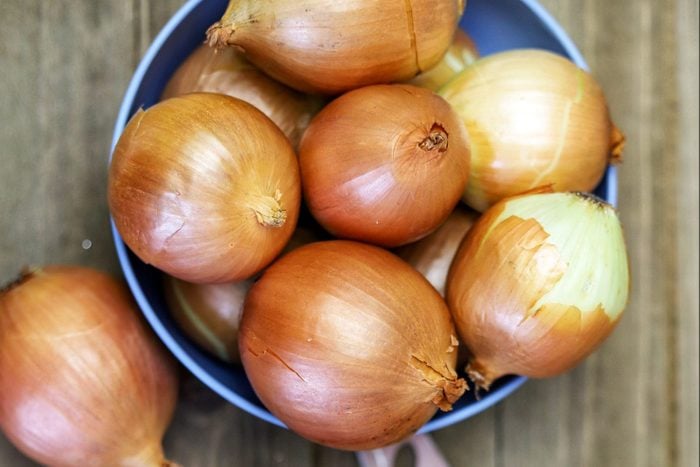
Onion
Allium cepa
Toxic components: Disulfides
The same components responsible for garlic’s pungent odor are also found in onions. “If a cat eats only a small amount one time, the damage to the cat’s red blood cells will be too small to cause any noticeable effect,” says Dr. Myers. “[However], if a cat eats a really large amount all at once—or consumes a more moderate amount frequently over a long period of time—the amount of damage can increase to the point where the cat becomes anemic. That’s when you’ll start to see symptoms.”
Swap it: Similar to garlic, you don’t have to eliminate onions entirely from your home. Just be mindful of storage and usage. If you’re looking to eat what you grow, these are the easiest vegetables to grow at home.
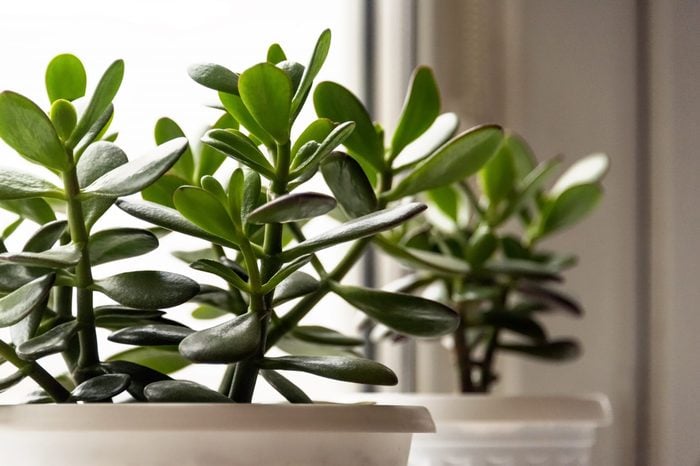
Jade
Crassula
Toxic component: Unknown
Also referred to as rubber plants, money plants or lucky plants, jade can cause vomiting, neurological symptoms such as incoordination and sometimes even depression, says Dr. Zacharias. The toxic component isn’t completely understood at this point, but it’s important to seek veterinary care immediately if you suspect your cat has eaten this plant. “Treatment will consist of vomiting only if the patient is not neurologically impaired (i.e., not acting ‘drunk’ or uncoordinated), activated charcoal, intravenous fluids to help support the patient and flush the toxin more rapidly from the body, monitoring and symptomatic support,” says Dr. Zacharias.
Swap it: The haworthia retusa, a type of succulent, offers the same thick and juicy leaf structure as jade, but it’s not a plant that’s toxic to cats.
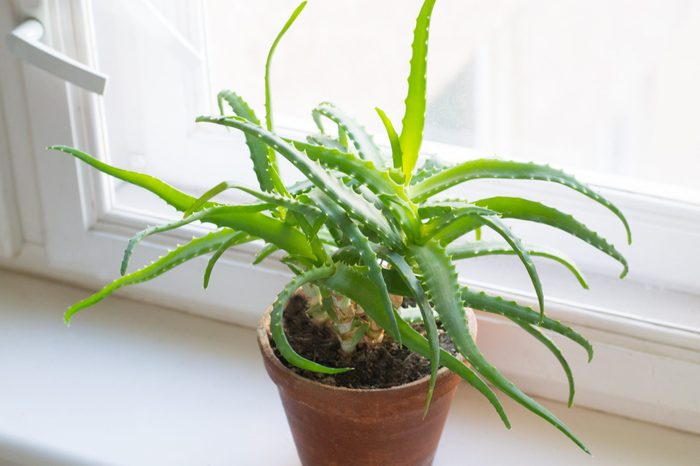
Aloe vera
Liliaceae
Toxic components: Saponins, anthraquinones
Though aloe vera is often a household staple—especially in the kitchen, where its healing powers can be employed at the ready—this plant is toxic to cats. The gel itself is actually considered edible when extracted, but the thick plant material that surrounds the gel can cause gastro upset (including vomiting), lethargy and diarrhea, says the ASPCA.
Swap it: The zebra succulent is technically smaller, but it offers a similar aesthetic. You can buy these plants in varying sizes and colors, and because they’re also succulents, they’re just as easy to care for. If you do kill yours, though, read through these pro tips on how to revive a dead plant.
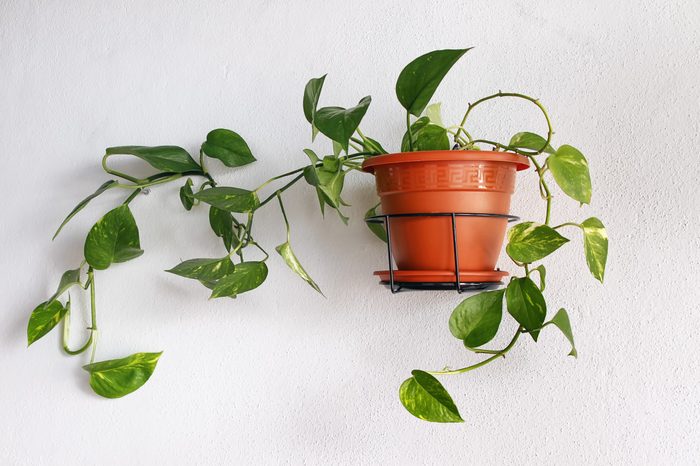
Devil’s ivy
Epipremnum aureum
Toxic components: Insoluble calcium oxalates
This plant goes by a few different names, including pothos, golden pothos and taro vine. Dr. Zacharias says, “It contains insoluble calcium oxalates that cause mouth, throat, tongue and lip irritation, [as well as] intense burning, excessive drooling (hypersalivation), vomiting and difficulty swallowing.”
Swap it: The Chinese money plant of the Pilea genus family is considered nontoxic to cats and offers the same drooping aesthetic as ivy. Bonus: Those types of nontoxic plants may also bring good feng shui into your home.
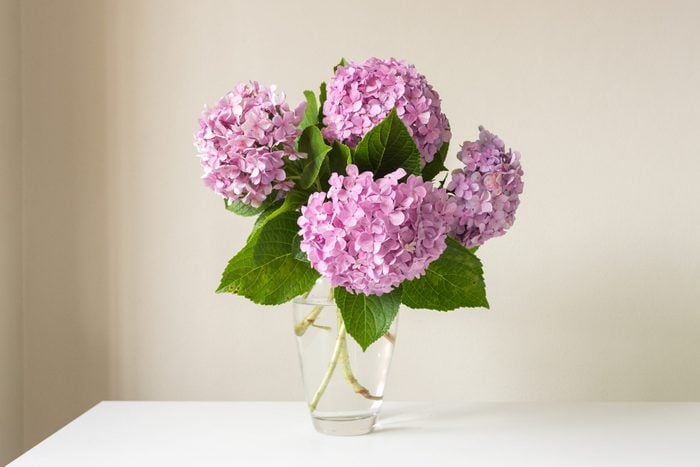
Hydrangea
Hydrangeaceae
Toxic component: Cyanogenic glycoside
Hydrangea blossoms are known for their lush, colorful beauty, but they can cause your cat to become ill if consumed. “When a cat eats enough hydrangea to get sick, we expect symptoms to start within a couple of hours of eating the plant,” says Dr. Myers. “Most cats will become nauseated, drool a lot and start to vomit. Diarrhea usually follows, and that diarrhea may be very bloody.”
Swap it: Available in a broad range of beautiful colors, zinnias make an excellent nontoxic alternative to hydrangea. Dealing with powdery mildew on plants? It’s more common than you might think!
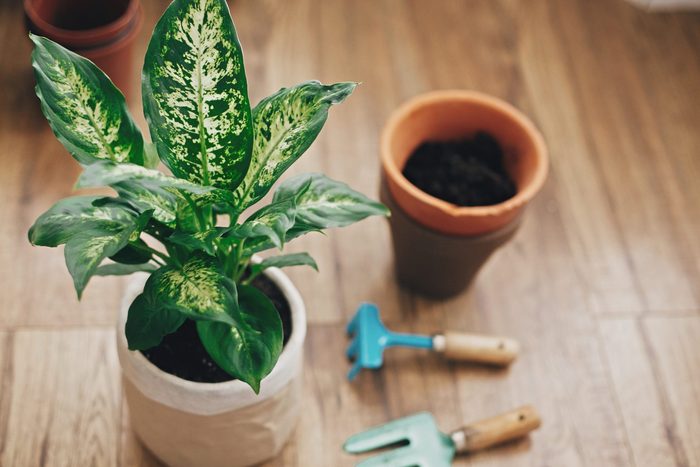
Dumbcane
Dieffenbachia
Toxic components: Insoluble calcium oxalates, proteolytic enzymes
There are many varieties of the dumbcane—including the giant dumbcane, charming dieffenbachia and exotica perfect—and all these plants are toxic to cats. According to the ASPCA, ingesting it can cause oral irritation, intense burning of the mouth, tongue and lips, excessive drooling, difficulty swallowing and vomiting. If you suspect your cat has consumed dumbcane, call the poison control hotline and/or your veterinarian for assistance immediately.
Swap it: The prayer plant looks very similar to dumbcane, but it’s cat-safe and vet-approved. Plants can experience a range of issues; this is what it means if yours develops tiny fungus balls.
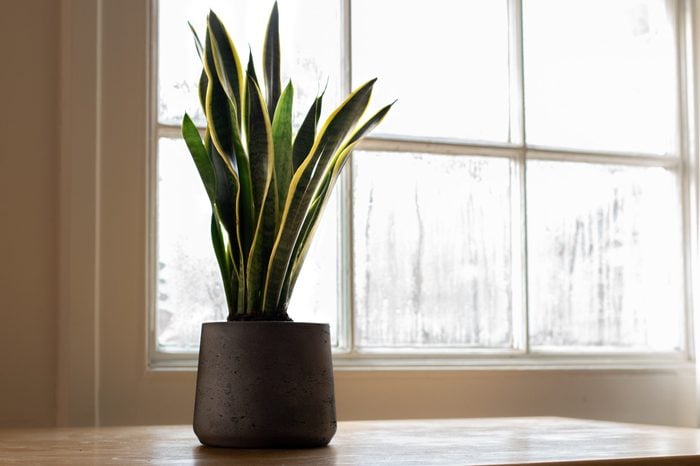
Snake plant
Sansevieria trifasciata
Toxic components: Saponins
The snake plant is a wildly popular hard-to-kill houseplant anyone can grow. However, snake plants contain chemical compounds called saponins, which result in feline nausea, vomiting and diarrhea if consumed or chewed on. If you suspect your cat has chewed on or eaten a snake plant, call your veterinarian or a hotline immediately. You’ll be given instructions based on the severity of the symptoms.
Swap it: The caeroba is a nontoxic plant that very closely resembles a snake plant with its beautiful, lush and pointed leaves. In fact, it’s sometimes called a “rattlesnake plant.” Also consider a spider plant, instead, which is nontoxic to pets.
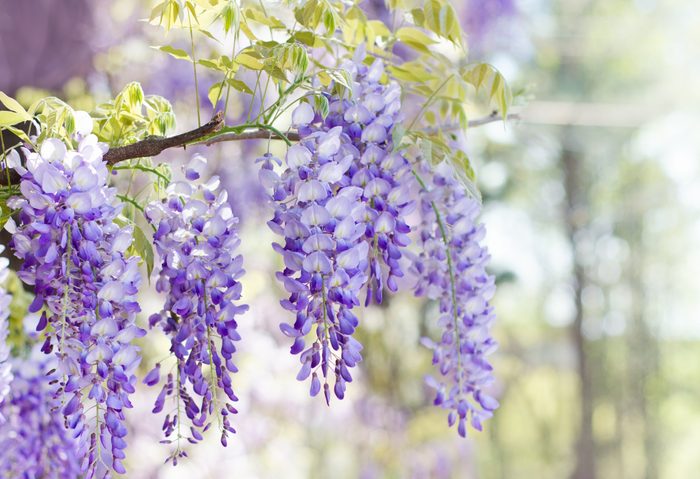
Wisteria
Fabaceae
Toxic components: Lectin, wisterin glycoside
The winding wisteria plant is renowned for its beauty and fragrance, but cat owners should skip this pretty plant with purple flowers. When it’s consumed, the effects aren’t quite as severe compared with other plants, but cats can still experience gastro upset that can lead to vomiting and diarrhea (sometimes bloody), and even depression. It’s not just plants that may be dangerous to pets; these common foods are toxic to cats too.
Swap it: Petunias, which you can find in a lovely shade of purple, get the stamp of approval for cats.

Amaryllis
Amaryllidaceae
Toxic component: Lycorine
These gorgeous flowers don’t just attract people. Cats may also be drawn to the giant, vibrant flowers that are often found in floral arrangements or planted as bulbs. But when they nibble on this type of lily, they can experience stomach pain, excess drooling, tremors, diarrhea, vomiting and a decrease in appetite, according to the ASPCA.
Swap it: Orchids offer an exotic burst of color and are nontoxic to cats. If you buy a potted orchid, it’ll last even longer. If you’re ordering flowers online for a friend or family member, you’ll also want to keep these pet-friendly tips in mind when making your selection.
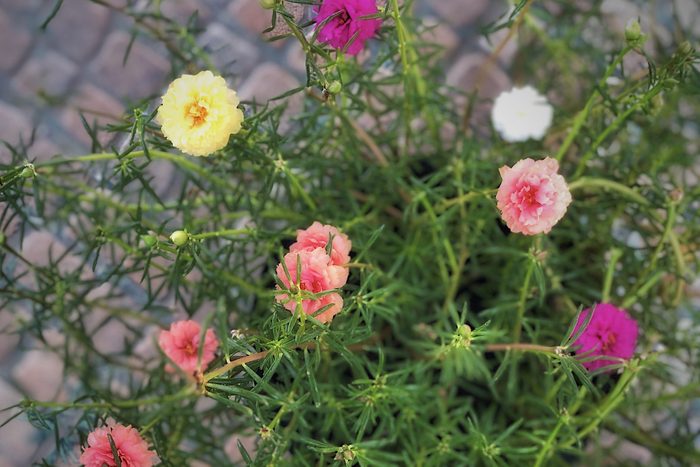
Moss rose
Portulaca oleracea
Toxic components: Soluble calcium oxalates
This colorful flowering plant is also referred to as rock moss and purslane, so be aware when you’re plant shopping. Despite its beauty, this houseplant is incredibly poisonous to cats—and can even be deadly—so you should avoid it altogether. It can result in tremors, kidney failure and hypersalivation, and if your cat has ingested it, you should seek immediate emergency treatment. “Treatment will include inducing vomiting, gastrointestinal decontamination, intravenous fluid therapy for one to three days minimum, monitoring and any supportive treatment,” says Dr. Zacharias.
Swap it: If you’re craving a colorful plant, try the African Daisy instead. You might also know it as the gerbera daisy, which you can get potted or nonpotted.
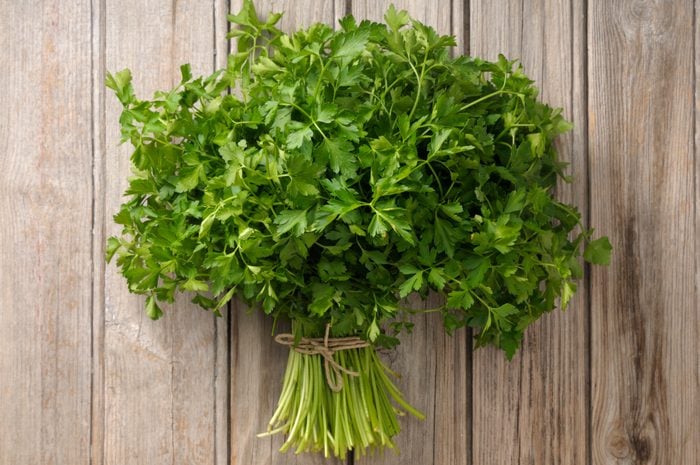
Parsley
Apiaceae
Toxic components: Furanocoumarins
Often used as a garnish in dishes and one of the easiest plants to grow in small spaces, parsley is unfortunately not an ideal plant to keep around if you’re a cat parent. Like some plants on this list, its toxicity isn’t as dangerous compared with others. However, when consumed in large quantities, or consistently over time, it can cause photosensitization that makes your cat more susceptible to sunburns, says the ASPCA.
Swap it: Sometimes confused for parsley (though boasting a taste you either love or hate), cilantro is an alternative you won’t have to worry about.
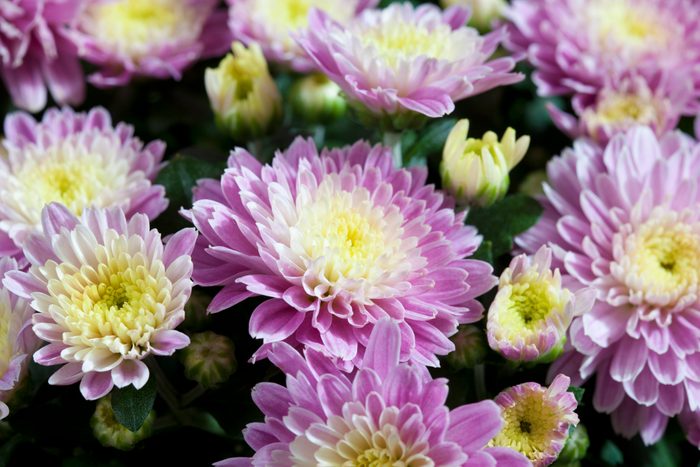
Chrysanthemum
Compositae
Toxic components: Sesquiterpene, lactones, pyrethrins and other potential irritants
Often simply abbreviated to mums, this is another colorful flowering plant that’s off-limits to cats because of its toxicity. Consumption can result in vomiting, diarrhea, hypersalivation, incoordination and dermatitis (a skin reaction). “Immediate veterinary treatment is needed,” says Dr. Zacharias. “Treatment will include controlling clinical signs with anti-emetics and anti-diarrhea medication, bathing if the skin is affected and possibly intravenous supportive fluid therapy.”
Swap it: With their colorful flowers and rich foliage, African violets make a great, nontoxic alternative to mums.
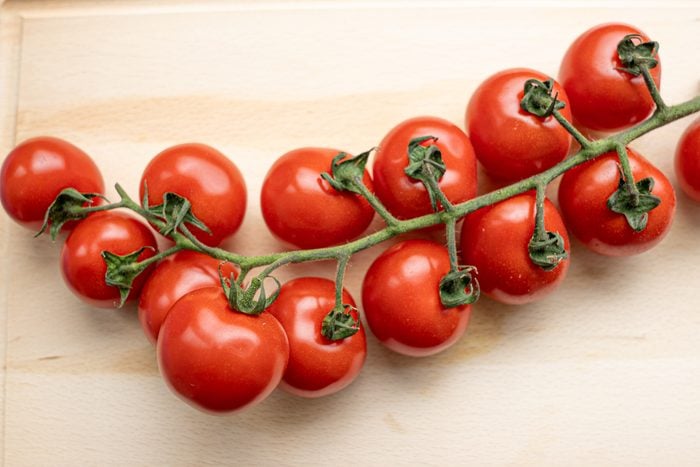
Tomato plant
Solanaceae
Toxic component: Solanine
As part of the nightshade family, tomato plants contain a substance called solanine that is toxic to pets—and even has some question if tomatoes are poisonous. The green vine and nonripened fruits are poisonous and, when consumed, can cause drooling, loss of appetite, severe gastro upset, slowed heart rate, and dilated pupils, notes the ASPCA.
Swap it: It’s best to keep your tomato plants on the patio or in the garden—and well out of your cat’s reach. And if you have an outdoor kitty, make sure to read these tips on how to keep cats (and dogs) out of your garden. If you want to grow a fruiting vine plant indoors, try the nontoxic buttercup squash instead. While many vining squashes do require larger spaces, buttercup squash is a smaller plant that can thrive inside when grown in deep pots with access to sunlight and soil that stays moist.
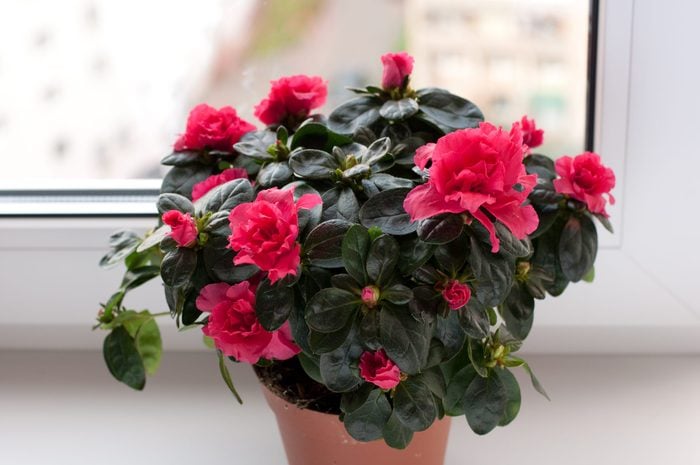
Azalea
Ericaceae
Toxic component: Grayantoxin
Azaleas are typically grown as ornamental outdoor foliage, but they’re also found in floral arrangements or sometimes kept as indoor potted plants. If your cat eats any part of the plant, it can cause vomiting, diarrhea, weakness and potentially cardiac failure.
Swap it: For a similar splash of color, try the red camellia as an alternative.
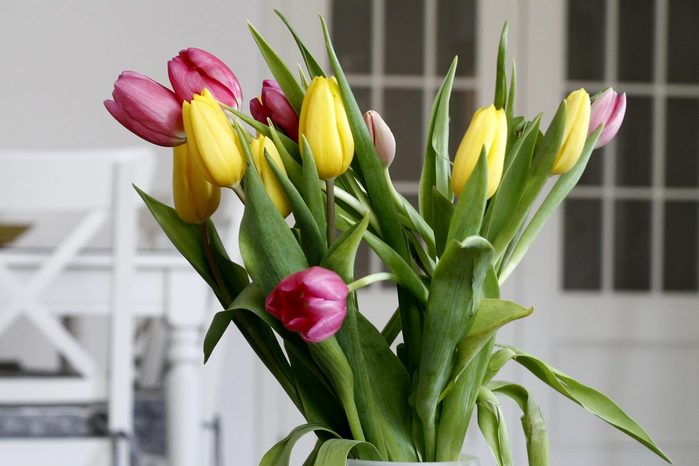
Tulip
Liliaceae
Toxic component: Tulipalin A and B
A springtime favorite, tulips are among the most notable poisonous plants to cats. According to Dr. Zacharias, the bulb has the highest concentration of toxins, but the entire plant itself is actually poisonous. Reactions include vomiting, depression, diarrhea and hypersalivation. Consult your vet right away to control clinical signs and prevent dehydration.
Swap it: Instead of tulips, opt for another springtime favorite—peonies. This fluffy floral, technically known as camellia japonica, comes in many colors and offers that burst of pastel beauty we often crave once temperatures begin to rise.
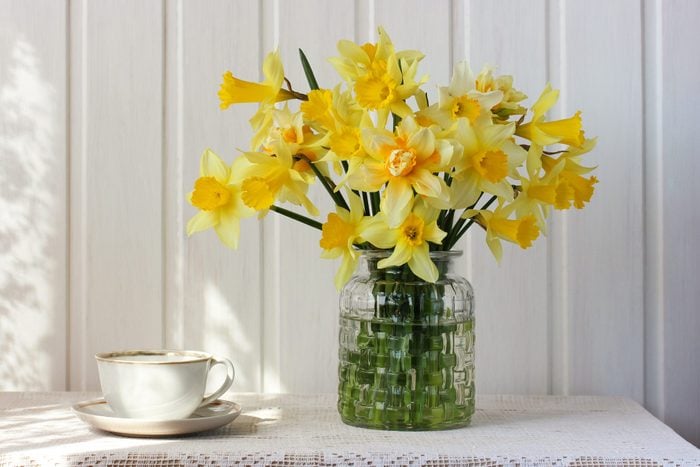
Daffodils
Narcissus
Toxic component: Lycorine and other alkaloids
Daffodils are another beautiful spring flower known for their buttery color and unique shape. Unfortunately, they’re also toxic to cats. Both the flower petals and bulbs are poisonous if consumed, warns Megan McCarthy, DVM, veterinarian at Best Friends Animal Society, and even the water from the vase is toxic.
“Symptoms range from mild to severe, with gastrointestinal upset the most common symptom,” notes Dr. McCarthy. This can lead to salivation, vomiting and diarrhea. “If your pet consumes a large amount of daffodils, symptoms can become more severe and include convulsions, low blood pressure, tremors and irregular heart rhythms.”
If your cat eats daffodils, remove access to the plant right away and contact your veterinarian. Calling ASPCA pet poison control or the Pet Poison Helpline right away is also a smart move. Pet lovers should also know the dangerous mistakes cat owners should never make.
Swap it: Instead of daffodils, consider bringing freesia into your home. This popular springtime flower comes in a range of beautiful hues—including yellow, pink and purple—and smells lovely.
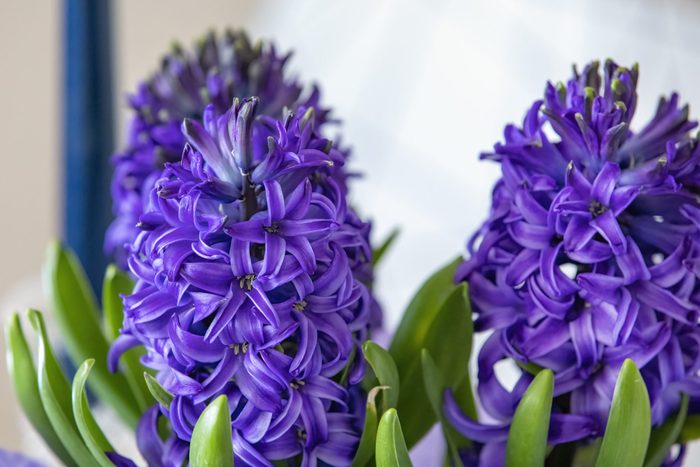
Hyacinth
Hyacinthus
Toxic component: Alkaloids, including lactones
While the entire hyacinth plant is toxic to cats, the bulbs contain the highest concentrations of alkaloids.
“Toxicity due to ingesting hyacinths is moderate to severe. If bulbs are chewed on or consumed, your cat can develop oral and esophageal irritations causing drooling and nausea,” explains Dr. McCarthy. “Consumption of hyacinths can also cause intense vomiting and diarrhea, sometimes with blood. Severe toxicity can cause depression, tremors, increased heart rate and respiratory rate, and difficulty breathing.
If your cat consumes hyacinth, contact your veterinarian and/or the ASPCA hotline promptly.
Swap it: The snapdragon is a lovely alternative to hyacinth. Not only does it have a similar shape, but it even comes in the same color varieties.
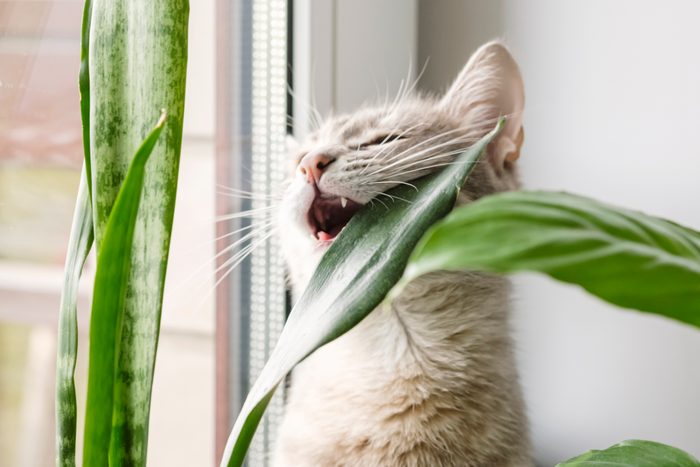
What to do if your cat chews or eats toxic plants
While keeping your cats away from plants is ideal, if you suspect that your cat has chewed on or ingested a potentially toxic plant in your home or garden, Dr. Zacharias recommends taking a picture of the plant and immediately heading to your veterinarian. It does not matter the quantity they consumed—it is better to be safe because the repercussions can be that dire. Plus, the plant does not have to be ingested in order to be poisonous. Simply chewing on the plant can be toxic. “Often, the ASPCA poison control hotline can be called en route to the hospital or once the cat has arrived,” she adds. “How quickly treatment is started often makes a significant difference in the patient’s health and outcome.”
You shouldn’t attempt to induce vomiting in a cat by giving hydrogen peroxide or any other over-the-counter emetics such as ipecac, no matter what you’ve read on the internet. A veterinarian’s expertise is needed here.
It’s also important to note that cats are very skilled at hiding their symptoms—it’s a defense mechanism that keeps them safe. Call your vet or the ASPCA hotline if you suspect that your cat has eaten one of these poisonous plants, even if they aren’t acting overtly sick. That said, symptoms such as diarrhea, lethargy and vomiting are all difficult to hide, so be on the lookout for those signs, specifically. Next, review these additional household items that are hazardous to pets.
Sources:
- Shelly Zacharias, DVM, veterinarian and vice president of medical affairs at Gallant
- Jo Myers, DVM, veterinarian expert for JustAnswer
- Megan McCarthy, DVM, veterinarian at Best Friends Animal Society
- ASPCA: “Poisonous Plants”
